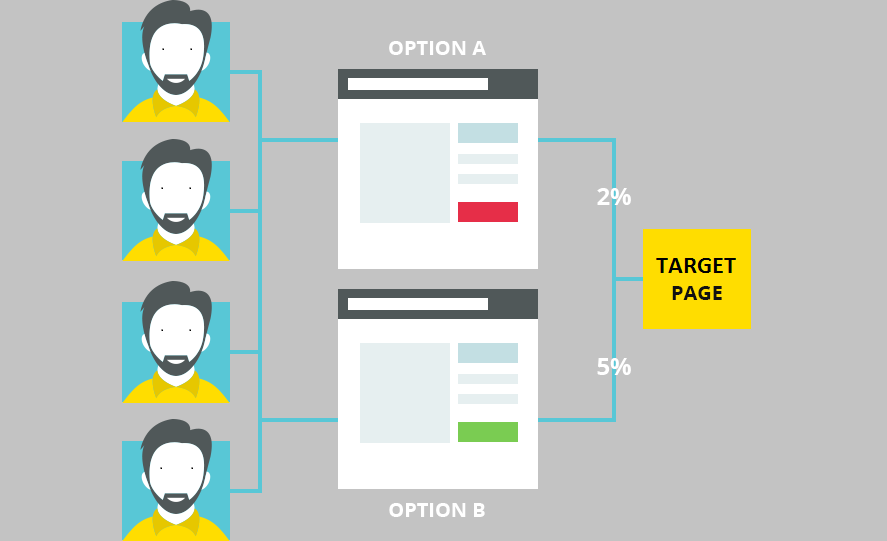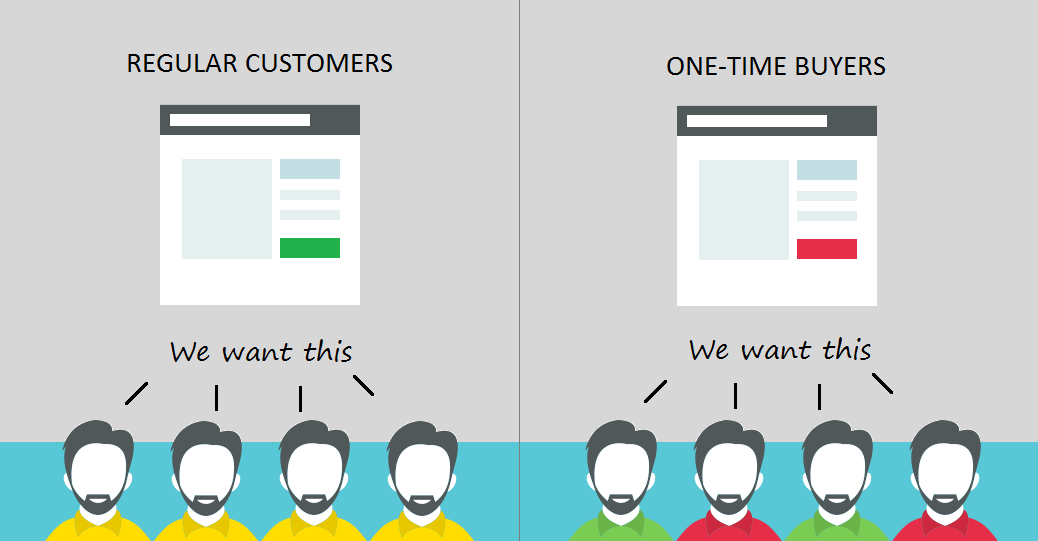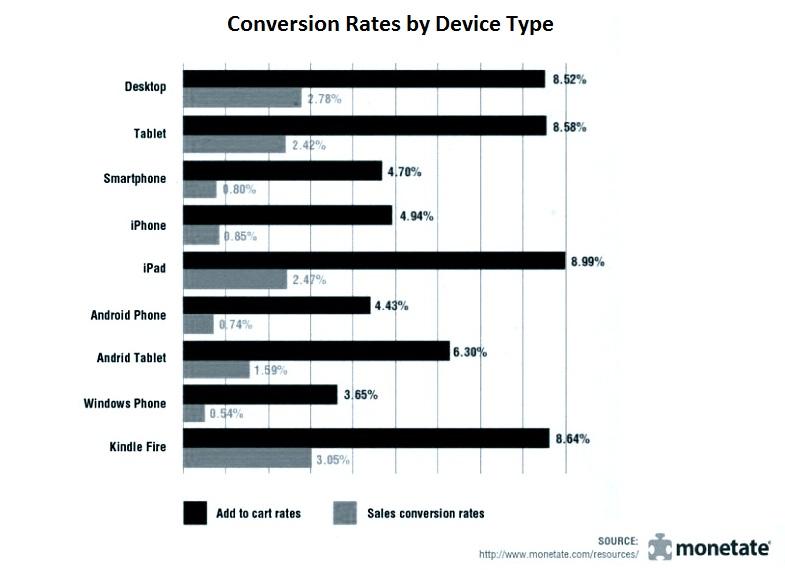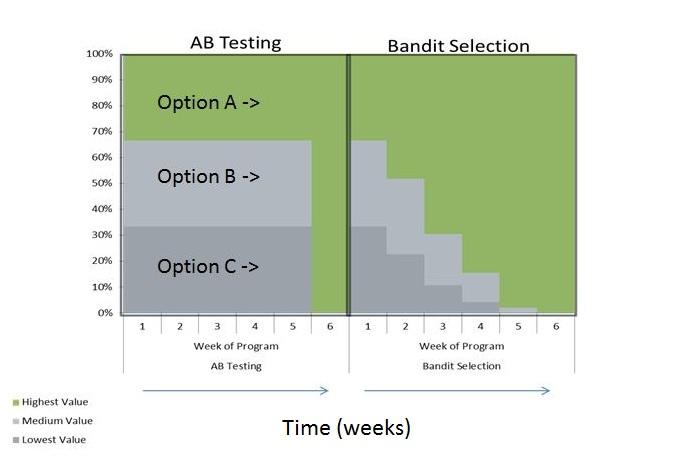A/B testing is one of those conversion optimization techniques – which on one side, has become a favorite tool for marketers with the growth-hacking mindset; but on the other hand, is still being overlooked by a good number of startups.
In its very definition, A/B testing requires testing of two or more versions of a web element/entity against each other to find out the better one. Most SMBs, with their limited resources, find creating & testing these multiple versions of their website, or webpage, or even image – an extra expenditure. They eventually feel content with going ahead without testing variations of the element/entity.
If done right, A/B testing can bring substantial ROI, enough to compensate that extra expenditure of resources. To make sure that your startup does A/B Testing right, here in this post, we will discuss how to reap the maximum benefits from this conversion optimization tactic.
But first, let us quickly go through some basics:
A Few Basics…
 Image: A simple illustration explaining the purpose of A/B Testing
Image: A simple illustration explaining the purpose of A/B Testing
Today, A/B testing is extensively used for analyzing the conversion potential of different versions of landing pages & CTAs (call to action). Besides these, it is also widely used for web copies, emails, and ads (even popular ad networks, such as Google AdWords, provide the option for A/B testing ads by default).
For any startup or marketer, practicing A/B testing for the first time, the key to run more effective & efficient tests is to know which elements to include. Some of the most common A/B testing elements you should focus on are:
- Headlines
- Page layout
- Lead capture form
- Trust indicators
- Call to action
- Content copy
- Images, videos, and other media content
Pretty much all of these elements will be tested for factors like position, color, font, visibility, & length across different versions.
Now, let’s move ahead & see how experts approach A/B Testing to improve their website’s conversion rate marginally.
Run Tests during Sale Seasons
Sale/holiday seasons are a good time to run your A/B testing campaign as a huge number of customers would be visiting your website to check offers, products, deals, and make purchases. With more customers testing your web-copy’s (or offer, or CTAs, etc.) versions, you are likely to get better results.
To get a clearer picture, consider this – if I were to ask 10 Americans at random, whether they support Trump, it is quite possible that all 10 (or 8 or 9) might say yes. But as I increase the size from 10 to 100 to 10,000 to 1,000,000, I will certainly get a much better picture on people’s opinion.
Test Only Repeat Visitors
This is one way to get more relevant results out of your A/B testing endeavors. But not all might agree with this tactic, since it implicitly means leaving out the one/first-time visitors altogether.
The reason behind implementing this tactic is obvious – you would be enhancing the experience for the customer segment that brings your repeat business and has the highest customer lifetime value (which is apparently the right customer segment to focus on).
 Image: Importance of focusing on regular customers during A/B Testing
Image: Importance of focusing on regular customers during A/B Testing
Besides, you can run test for both segments separately & lead each segment to their preferred experience. This certainly would require a little bit of extra effort, but will also bring optimum results.
Run Tests for Mobile Separately
When scroll is replaced by swipe, click by tap, & navigation by hamburger menu – customer behavior is bound to vary greatly across devices. In fact, it is quite possible that a CTA button that converts a lot on desktop might also be the reason behind decline of mobile sales. Therefore, it is imperative for businesses to run test separately for the mobile platform.
Another thing web owners need to keep in mind is that conversion rate on mobile is far less than desktop. Reason being, mobile is mostly used for exploring not buying. So, the test cases for mobile should be designed focusing on engagement. Ultimately, it will help improve your overall conversion rate across devices.
 Image: Conversion rates across different devices & platform (source: Monetate)
Image: Conversion rates across different devices & platform (source: Monetate)
Optimize your CTAs to make them more effective across all devices & platforms
Use A/B Testing Tools
From creating test cases to analyzing their results, today, there are several tools to streamline your A/B testing endeavors & make the whole process quite efficient.
Some of the prominent names in the A/B Testing tools sector are:
For simplicity’s sake, we have listed only a handful of tools with their prime use. To explain which tool is best in which case is beyond the scope of this post. So, we suggest readers to a little research on the matter.
Do Bandit Testing
A quick definition first – bandit testing is a more flexible variant of A/B testing in which instead of evenly splitting the exposure across all versions, the best version continuously gets more exposure than others. Here the image below will clarify it further:
 Image: Illustration to show difference between A/B & Bandit Testing (Source: Conductrics)
Image: Illustration to show difference between A/B & Bandit Testing (Source: Conductrics)
Doing bandit testing is ideal in situation where you already have an inclination (logical) towards a particular version and it performs well in the initial stage. Referring to the image above, obviously, there is no point in continuing to provide equal exposure to all three options when A is continuously converting better than others.
Also read: 5 conversion rate optimization hacks that you probably didn’t know about
Conclusion
The concept of A/B testing goes much deeper than what we have covered here; plus, in practice, it will bring along much more complex scenarios that what we have illustrated in the images above. The important thing is to move in the right direction and follow smart practices (such as mentioned in the post above) that ensure improvement in conversion rate in the most efficient manner. And that’s what would make your investment on A/B testing worthwhile.
Improve your website’s conversion with FATbit’s CRO Services

 Image: A simple illustration explaining the purpose of A/B Testing
Image: A simple illustration explaining the purpose of A/B Testing Image: Importance of focusing on regular customers during A/B Testing
Image: Importance of focusing on regular customers during A/B Testing  Image: Conversion rates across different devices & platform (source: Monetate)
Image: Conversion rates across different devices & platform (source: Monetate) Image: Illustration to show difference between A/B & Bandit Testing (Source: Conductrics)
Image: Illustration to show difference between A/B & Bandit Testing (Source: Conductrics)
